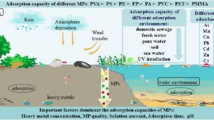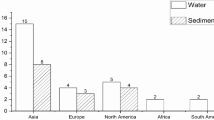Abstract
This article summarizes the main extraction methods for sedimentary phosphorus (P) determination. With sequential chemical extractions, P is supposed to be selectively removed from different compounds in the sediments. Extraction schemes using strong acids and alkaline solutions have been tested on different sediments and found not to extract well-defined fractions. In addition, several systematic errors in these schemes have been detected. Thus, these schemes have been modified and simplified accordingly. The Standards Measurements and Testing Program of the European Commission (SMT) method is a popular modification of these extraction schemes, as it is simple to handle, allows laboratories to achieve reproducible results and could provide a useful tool for routine use by water managers. The SEDEX (sequential extraction method) method, another popular modification, is widely applied in biogeochemical research as it can separate authigenic carbonate fluorapatite from fluorapatite. Other chemical extractions using chelating compounds have attempted to extract P bound with iron and calcium in sediments without disturbing clay-bound or organic P, the purpose being to determine the algal-available non-apatite, apatite and organic fractions of sediment P. All extraction procedures still yield operationally defined fractions and cannot be used for identification of discrete P compounds. Future modifications of the extraction scheme should aim to achieve better extraction efficiency and selectivity, simple handling techniques and methods that can prevent the extracted P from being re-adsorbed onto Fe(OOH) and CaCO3.
Similar content being viewed by others
References
Ahlgren J, Reitzel K, Tranvik L, Gogoll A, Rydin E (2006) Degradation of organic phosphorus compounds in anoxic Baltic Sea sediments: a 31P nuclear magnetic resonance study. Limnol Oceanogr 51(5):2341–2348
Ahlgren J, Brabandere HD, Reitzel K, Rydin E, Gogoll A, Waldebäck M (2007) Sediment phosphorus extractants for phosphorus-31 nuclear magnetic resonance analysis: a quantitative evaluation. J Environ Qual 36:892–898
Anderson LD, Delaney ML (2000) Sequential extraction and analysis of phosphorus in marine sediments: streamlining of the SEDEX procedure. Limnol Oceanogr 45(2):509–515
Anderson LD, Faul KL, Paytan A (2010) Phosphorus associations in aerosols: what can they tell us about P bioavailability? Mar Chem 120:44–56
Barbanti A, Bergamini MC, Frascari F, Miserocchi S, Roso G (1994) Aspects of sedimentary phosphorus chemical fractionation. J Environ Qual 23:1093–1102
Blake RE, O’Neil JR, Surkov A (2005) Biogeochemical cycling of phosphorus: insights from oxygen isotope effects of phosphoenzymes. Am J Sci 305:596–620
Burrus D, Thomas RL, Dominik B, Vernet J-P, Dominik J (1990) Characteristics of suspended sediment in the Upper Rhone River, Switzerland, including the particulate forms of phosphorus. Hydrol Process 4(1):85–98
Chang SC, Jackson ML (1957) Fractionation of soil phosphorus. Soil Sci 84:133–144
Condron LM, Newman S (2011) Revisiting the fundamentals of phosphorus fractionation of sediments and soils. J Soils Sediments 11:830–840
Dean LA (1938) An attempted fractionation of the soil phosphorus. J Agric Sci 28:234–246
Dorich RA, Nelson DW, Sommers LE (1985) Estimating algal available phosphorus in suspended sediments by chemical extraction. J Environ Qual 14:400–405
Fabre A, Qotbi A, Dauta A, Baldy V (1996) Relation between algal available phosphate in the sediments of the River Garonne and chemically-determined phosphate fractions. Hydrobiologia 335:43–48
Golterman HL (1982) Differential extraction of sediment phosphates with NTA solution. Hydrobiologia 92:683–687
Golterman HL (1995) The role of the iron hydroxide-phosphate-sulphide system in the phosphate exchange between sediments and overlying water. Hydrobiologia 297:43–54
Golterman HL (1996) Fractionation of sediment phosphate with chelating compounds: a simplification, and comparison with other methods. Hydrobiologia 335:87–95
Golterman HL, Paing J, Serrano L, Gomez E (1998) Presence of and phosphate release from polyphosphates or phytate phosphate in lake sediments. Hydrobiologia 364:99–104
Hieltjes AHM, Lijklema L (1980) Fractionation of inorganic phosphates in calcareous sediments. J Environ Qual 9:405–407
Hoyle C (2004) Phosphorus cycling in Lake Brienz, Switzerland. MSc thesis, EAWAG. ch., p 14
Hupfer M, Gächter R, Rüegger H (1995) Polyphosphate in lake sediments: 31P NMR spectroscopy as a toll for its identification. Limnol Ckeanogr 40(3):610–617
Jaisi DP, Blake RE (2010) Tracing sources and cycling of phosphorus in Peru margin sediments using oxygen isotopes in authigenic and detrital phosphates. Geochim Cosmochim Acta 74:3199–3212
Jensen HS, Thamdrup B (1993) Iron-bound phosphorus in marine sediments as measured by bicarbonate-dithionite extraction. Hydrobiologia 253:47–59
Jensen HS, McGlathery KJ, Marino R, Howarth RW (1998) Forms and availability of sediment phosphorus in carbonate sand of Bermuda seagrass beds. Limnol Oceanogr 43:799–810
Katsaounos CZ, Giokas DL, Leonardos JD, Karayannis MI (2007) Speciation of phosphorus fractionation in river sediments by explanatory data analysis. Water Res 41:406–418
Kerr JG, Burford M, Olley J, Udy J (2010) The effects of drying on phosphorus sorption and speciation in subtropical river sediments. Mar Freshw Res 61:928–935
Lukkari K, Hartikainen H, Leivuori M (2007) Fractionation of sediment phosphorus revisited. I: fractionation steps and their biogeochemical basis. Limnol Oceanogr Methods 5:433–444
Monbet P, McKelvie ID, Worsfold PJ (2007) Phosphorus speciation, burial and regeneration in coastal lagoon sediments of the Gippsland Lakes (Victoria, Australia). Environ Chem 4:334–346
Penn MR, Auer MT (1997) Seasonal variability in phosphorus speciation and deposition in a calcareous, eutrophic lake. Mar Geol 139:47–59
Penn MR, Auer MT, Van Orman EL, Korienek JJ (1995) Phosphorus diagenesis in lake sediments: investigations using fractionation techniques. Mar Freshw Res 46:89–99
Pettersson K, Boström B, Jacobsen O (1988) Phosphorus in sediments—speciation and analysis. Hydrobiologia 170:91–101
Psenner R, Pucsko R (1988) Phosphorus fractionation: advantages and limits of the method for the study of sediment P origins and interactions. Arch Hydrobiol Beih Ergebn Limnol 30:43–59
Psenner R, Bostrom B, Dinka M, Petterson K, Pucsko R, Sager M (1988) Fractionation of phosphorus in suspended matter and sediment. Arch Hydrobiol Beih 30:98–110
Ruban V, Brigault S, Demare D, Philippe A-M (1999a) An investigation of the origin and mobility of phosphorus in freshwater sediments from Bort-Les-Orgues Reservoir, France. J Environ Monit 1:403–407
Ruban V, López-Sánchez JF, Pardo P, Rauret G, Muntau H, Quevauviller P (1999b) Selection and evaluation of sequential extraction procedures for the determination of phosphorus forms in lake sediment. J Environ Monit 1:51–56
Ruban V, López-Sánchez JF, Pardo P, Rauret G, Muntau H, Quevauviller P (2001) Harmonized protocol and certified reference material for the determination of extractable contents of phosphorus in freshwater sediments—a synthesis of recent works. Fresenius J Anal Chem 370:224–228
Ruttenberg KC (1990) Diagenesis and burial of phosphorus in marine sediments: implications for the marine phosphorus budget. PhD thesis, Yale University, p 375
Ruttenberg KC (1992) Development of a sequential extraction method for different forms of phosphorus in marine sediments. Limnol Oceanogr 37:1460–1482
Schindler DW, Kling H, Schmidt RV, Prokopowich J, Frost VE, Reid RA, Capel M (1973) Eutrophication of lake 227 by addition of phosphate and nitrate: the second, third, and fourth years of enrichment, 1970, 1971, and 1972. J Fish Res Board Can 30(10):1415–1440
Sharpley AN (1993a) An innovative approach to estimate bioavailable phosphorus in agricultural runoff using iron-oxide impregnated paper. J Environ Qual 22:597–601
Sharpley AN (1993b) Estimating phosphorus in agricultural runoff available to several algae using iron-oxide paper strips. J Environ Qual 22:678–680
Simon NS, Lynch D, Gallaher TN (2009) Phosphorus fractionation in sediment cores collected in 2005 before and after onset of an Aphanizomenon flos-aquae bloom in Upper Klamath Lake, OR, USA. Water Air Soil Pollut 204:139–153
Tiyapongpattana W, Pongsakul P, Shiowatana J, Nacapricha D (2004) Sequential extraction of phosphorus in soil and sediment using a continuous-flow system. Talanta 62(4):765–771
Wang P, He M, Lin C, Men B, Liu R, Quan X, Yang Z (2009) Phosphorus distribution in the estuarine sediments of the Daliao River. China Estuar Coast Shelf S 84:246–252
Williams JDH, Syersa JK, Walter TW (1967) Fractionation of soil inorganic phosphate by a modification of Chang and Jackson procedure. Soil Sci Soc Am Proc 31:736–739
Williams JDH, Syers JK, Armstrong DE, Harris F (1971) Fractionation of inorganic phosphate in calcareous lake sediments. Soil Sci Soc Am Proc 35:250–255
Williams JDH, Jaquet J-M, Thomas RL (1976) Forms of phosphorus in surficial sediments of Lake Erie. J Fish Res Board Can 33:413–429
Williams JDH, Shear H, Thomas RL (1980) Availability to Scenedesmus quadricauda of different forms of phosphorus in sedimentary materials from the Great Lakes. Limnol Oceanogr 25(1):1–11
Yuan HZ, Shen J, Liu EF, Wang JJ, Meng XH (2010) Space distribution characteristics and diversity analysis of phosphorus from overlying water and surface sediments in Taihu Lake. Environ Sci 31:954–960
Zhang JZ, Fischer CJ, Ortner PB (2004) Potential availability of sedimentary phosphorus to sediment resuspension in Florida Bay. Glob Biogeochem Cycle 18:1–14
Acknowledgments
This study was supported by the National Natural Science Foundation of China (project no. 41006040), the government's Scholarship of Jiangsu Province, China, for study abroad, and the Priority Academic Program Development of Jiangsu Higher Education Institutions (PAPD). The authors appreciate the help of the reviewers and editors in revising this manuscript.
Author information
Authors and Affiliations
Corresponding author
Additional information
Handling Editor: Hiroshi Hasegawa.
Rights and permissions
About this article
Cite this article
Wang, C., Zhang, Y., Li, H. et al. Sequential extraction procedures for the determination of phosphorus forms in sediment. Limnology 14, 147–157 (2013). https://doi.org/10.1007/s10201-012-0397-1
Received:
Accepted:
Published:
Issue Date:
DOI: https://doi.org/10.1007/s10201-012-0397-1




